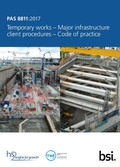PAS 8811:2017 Temporary works
Publicly Available Specifications (PAS) are fast-track standards, specifications, codes of practice or guidelines developed by sponsoring organisations to meet an immediate market need. They set industry-wide standards and are produced collaboratively by key stakeholders. If a majority consensus can be achieved, and if they are endorsed by BSI, then PAS function as if they are British Standards.
PAS 8811:2017 Temporary works – Major infrastructure client procedures – Code of practice was published by BSI in January 2017. It is one of two PAS’s sponsored by HS2 and the Temporary Works Forum and can be used in conjunction with PAS 8812 Temporary works – Application of European Standards in design – Guide, which gives guidance on the application of European standards in the fields of structural and geotechnical temporary works design.
PAS 8811:2017 provides guidance on procedures for temporary works aimed explicitly at major infrastructure clients. It complements, and is intended to be used in conjunction with, BS 5975 Code of practice for temporary works procedures and the permissible stress design of falsework expanding areas where there is limited information provided for major infrastructure projects.
It gives recommendations about procedures for temporary works and temporary conditions of permanent works during construction and covers; processes, roles, responsibilities, competences and documentation.
It establishes a unified approach across all stages of a project and eliminates unnecessary procedures and conflicts to ensure there is clarity and delays are minimised during compliance and approvals and other necessary procedures.
Orgnaisations that contributed to the PAS include; Aecom, Balfour Beatty, Carillion, CH2M, Costain, Crossrail, Groundforce, the Health & Safety Executive, HS2, Highways England, the Institution of Civil Engineers, Kier, London Underground, Morgan Sindall, Mott McDonald, National Access & Scaffolding Confederation (NASC), National Grid, Network Rail, Skanska, Tideway and Tony Gee & Partners.
[edit] Find out more
[edit] Related articles on Designing Buildings Wiki
Featured articles and news
RTPI leader to become new CIOB Chief Executive Officer
Dr Victoria Hills MRTPI, FICE to take over after Caroline Gumble’s departure.
Social and affordable housing, a long term plan for delivery
The “Delivering a Decade of Renewal for Social and Affordable Housing” strategy sets out future path.
A change to adoptive architecture
Effects of global weather warming on architectural detailing, material choice and human interaction.
The proposed publicly owned and backed subsidiary of Homes England, to facilitate new homes.
How big is the problem and what can we do to mitigate the effects?
Overheating guidance and tools for building designers
A number of cool guides to help with the heat.
The UK's Modern Industrial Strategy: A 10 year plan
Previous consultation criticism, current key elements and general support with some persisting reservations.
Building Safety Regulator reforms
New roles, new staff and a new fast track service pave the way for a single construction regulator.
Architectural Technologist CPDs and Communications
CIAT CPD… and how you can do it!
Cooling centres and cool spaces
Managing extreme heat in cities by directing the public to places for heat stress relief and water sources.
Winter gardens: A brief history and warm variations
Extending the season with glass in different forms and terms.
Restoring Great Yarmouth's Winter Gardens
Transforming one of the least sustainable constructions imaginable.
Construction Skills Mission Board launch sector drive
Newly formed government and industry collaboration set strategy for recruiting an additional 100,000 construction workers a year.
New Architects Code comes into effect in September 2025
ARB Architects Code of Conduct and Practice available with ongoing consultation regarding guidance.
Welsh Skills Body (Medr) launches ambitious plan
The new skills body brings together funding and regulation of tertiary education and research for the devolved nation.
Paul Gandy FCIOB announced as next CIOB President
Former Tilbury Douglas CEO takes helm.
UK Infrastructure: A 10 Year Strategy. In brief with reactions
With the National Infrastructure and Service Transformation Authority (NISTA).























